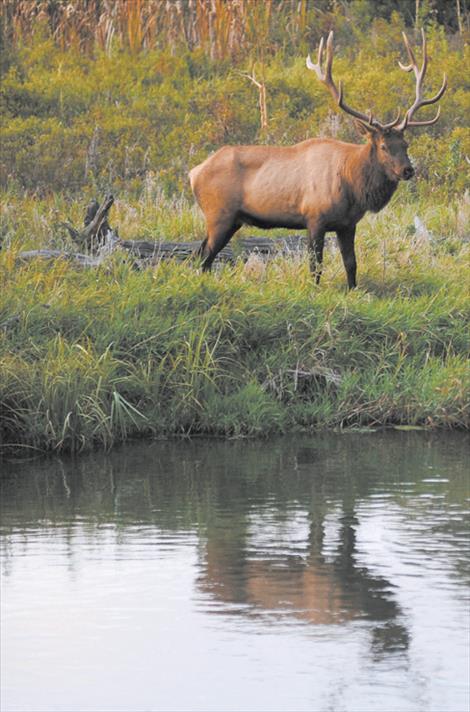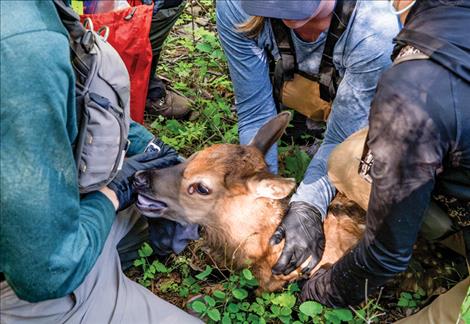Elk research: UM scientists, students study a changing population
Hey savvy news reader! Thanks for choosing local.
You are now reading
1 of 3 free articles.
By Emily Senkosky, UM News Service
MISSOULA – According to naturalist and author John Muir, between every two pines is the doorway to a new world. In Noxon, Montana, at a base camp for wildlife biologists nestled deep in the pines, camera traps and other measuring instruments are capturing forensic evidence of what is happening to the state’s elk population.
A new management plan released by Montana Fish, Wildlife and Parks last year has accelerated matters concerning the antlered ungulate, and an investigative team consisting of University of Montana wildlife biology professors and students is helping FWP spearhead research to understand the many complex factors affecting the species.
The town of Noxon is a two-and-a-half-hour drive northwest from Missoula, on the border of Idaho’s panhandle at the heart of Montana’s Hunting District 121. Over the past decade, the local community raised concerns about reduced elk populations with local wildlife managers.
“The public in Montana is passionate about wildlife, with elk being particularly important to the hunting public,” said Neil Anderson, an FWP regional wildlife manager. “When there are changes – especially when those changes aren’t viewed as being positive – the public looks for actions to improve the situation.”
Researchers are considering the many ecological factors that impact the species, including predator roles, habitat changes, population distribution and human modifications to the landscape.
Collectively, efforts aim to provide answers to foundational questions: Where are elk on the landscape, and what are the main drivers of their population dynamics? Although outcomes are still a work in progress, these scientists are diligently working to help ensure a balanced and sustainable future for Montana’s elk and the communities that depend on them.
The Fabric of the Landscape
Before this project began, there was limited data on elk mortality rates and population distribution in HD 121.
“There were many thoughts as to why elk numbers and distribution had changed, but no data to determine what was really happening,” Anderson said.
Previously, aerial counts were used in the area, but this method can only obtain an estimated minimum population abundance and cow-calf ratios. Noxon, like most of northwest Montana, also has a unique ecosystem due to its dense forested areas and humid climate, making this method potentially inaccurate due to the difficulty of sighting and counting elk.
Data from other studies in western Montana and even nearby areas in Idaho also have been used to make inferences for what’s happening in Noxon, said Chad Bishop, director of UM’s Wildlife Biology Program, who helps oversee the project. He said this hasn’t provided a real snapshot of Noxon’s elk.
“The issues regarding wildlife can be really complex depending on what kinds of landscape you’re evaluating,” Bishop said. “This project is aimed at getting a holistic view of what’s going on with this specific population.”
The Noxon elk project is the largest research effort in recent times within the hunting district and includes the collaborative fieldwork of experts ranging from UM students to wildlife researchers and FWP staff. Project members spend weeks at a time in the Noxon area, staying at the study sites both in the winter and summer to tease apart the various factors that could influence elk.
“Having accurate information on wildlife populations forms the framework for discussions,” Anderson said. “Information from this study helps inform biologists and carries a lot of weight in determining what tools to use to achieve management goals.”
According to many of the students and FWP representatives, local community involvement is key to project success. Landowners have allowed camera traps to be set up on their property and worked one-on-one with the students and researchers.
“This is a major research project that will address important questions for elk management in an area where elk are especially important ecologically and culturally,” Bishop said. “The research will simultaneously contribute to the professional development of students who will be the future stewards of Montana’s wildlife.”
In particular, he said, students learn the value of working alongside private landowners and management agency biologists as part of conducting rigorous research with an applied focus.
A Changing Habitat
Researchers on the project are leaving no leaf left unturned – literally or figuratively – as they investigate what environmental factors impact elk.
Trevor Weeks, a UM wildlife biology master’s student advised by Bishop, studies vegetation in HD 121 habitat. Elk are herbivores, so the quantity and quality of forage and landscape disturbance can be critical. His main task is to gather information that can help piece together an elk’s diet in this area.
“Environmental variability matters a lot with population dynamics,” Bishop said. “Oftentimes, the big-picture driver of a species’ decline is tied to a reduction in habitat quality.”
By understanding what elk eat and the nutritional value of their diet, Weeks’ work supports the project’s overarching goal of developing models that predict how elk use the landscape. In his meticulous fieldwork, he documents every plant species within a square meter frame, dries them out and weighs them. He then collects scat for a DNA metabarcoding analysis, cross-comparing the results to model what specific things elk are eating. This data also can help predict the amount of forage available in different areas of the study site.
Weeks has identified 45 unique diet items for elk in Noxon. This includes plants such as huckleberries, raspberries, roses, fireweed and clovers. With foundational knowledge on the values of elk nutrition, his research later can be used to inform population changes.
Weeks also studies impacts of forest disturbances on elk nutrition, such as timber harvesting or prescribed fires. By examining forage across sites that are disturbed versus undisturbed, he can categorize the major forest types and historical trends to get a glimpse into an elk’s nutritional intake within the larger ecosystem. Weeks emphasizes the need to understand elk nutrition as it can have significant long-term impacts on the population.
“Nutrition can impact a lot of things. Understanding their diet creates steppingstones to see what is impacting the population,” Weeks said. “We’re looking at this situation comprehensively – both top down and bottom up – meeting in the middle to figure out all the factors affecting elk.”
Population Dynamics
Karly Tellier, also a UM master’s student in wildlife biology, is working to obtain a more representative estimate of both elk and carnivore populations in the hunting district. As part of a wildlife modeling team, she helps deploy different types of field cameras, a technique championed by her adviser Paul Lukacs, UM senior associate dean of research and graduate studies.
This part of the research uses over 100 camera traps, with 80 randomly and 40 semi-randomly placed near game trails, to gather a more accurate portrayal of predator-prey ratios. The study area covers about 2,500 square kilometers (about the size of Yosemite National Park) around Noxon on private and public land.
“Paul has revolutionized the use of field cameras to estimate abundance of species,” Bishop said. “He’s led that nationally and internationally. We have brought that technique in on this, and it is really helping to glean good data.”
The cameras also provide time-lapse images throughout the landscape every 10 minutes at random. By ensuring a constant data stream unaffected by motion sensors, the researchers can construct a clearer picture of elk movements and predator-prey interactions. Similar to an approach used in Idaho, the strategy allows for noninvasive monitoring of these populations under dense vegetation and tree canopies where traditional aerial surveys struggle to penetrate.
Finally, the use of both random and semi-random cameras aims to capture more accurate species density estimates. This is especially prevalent when trying to get a count of predators like wolves, which avoid cameras and have been one assumption as to why elk populations are decreasing.
“FWP wants to better understand through data how to improve the balance between prey, predator and private homeowners so that harmony can be achieved on the landscape,” Tellier said.
Tellier is helping to collect data around the time of elk births and during hunting seasons to compare population numbers and distributions. This also helps understand elk migration patterns, particularly the shifts in abundance throughout the year. Through images and data modeling, this approach helps determine whether predators or elk behavior adaptations are contributing to the decline in bull elk harvests observed over the past decade.
Chris Hansen, a UM post-doctorate on the project, supports and assists with modeling. He works to make sense of existing FWP elk data, using it as a baseline for the current research. Hansen will take all the information currently being excavated in the field and piece it together in a model that helps project where elk are today, the drivers of their dynamics and their distribution in the landscape.
Elk Reproduction vs. Survival
UM Ph.D. candidate Andy Stewart and her adviser, Professor Joshua Millspaugh, have traced reproduction versus survival rates of Noxon elk through a variety of different data-capture methods. Stewart’s efforts are aimed at estimating population abundance and movements by using expandable satellite GPS collars administered to elk calves.
These collars serve multiple purposes. First, they provide precise survival data by sending mortality signals if the collar remains still for six hours, allowing researchers to quickly reach the site where an elk has died to gather accurate cause-specific mortality information. Additionally, the collars enable researchers to monitor surviving animals’ data – informing scientists about elk activities such as migration patterns, routes and landscape use.
Stewart also used transmitters placed in the vaginal canals of elk cows in the wintertime to confirm pregnancies. The transmitters communicate with the GPS collars when a birth is taking place. This data is sent to satellites and then back to the researchers so they can accurately track birth rates.
“Andy’s research ties everything together, looking at population and vital rates, which have the biggest impact on population growth,” Bishop said.
Nicole Bealer, a recent graduate of the UM wildlife biology program now working for FWP, collaborates closely with Stewart. Bealer spent months developing new analytic tools to bolster collaring strategies. She also used coding to create algorithms that could more accurately predict calving locations, with the goal of detecting birth events in real time.
When the transmitters tell researchers an elk has been born, they dispatch to the location and collar the calves to better inform survival rates after birth – making it so the researchers can not only track reproduction but the number of calves making it to adulthood as well.
“I’m hopeful that at the conclusion of this project all of the various people invested in it will be excited to learn what we have found,” Bealer said.
The ability to accurately track elk survival and mortality factors means wildlife managers are better informed about administering hunting licenses and adjusting season dates to help better support their populations. When there are higher numbers of elk, not only does the ecosystem thrive but the hunters who rely on the species do too.
Project funding was provided by revenue from the sale of Montana hunting and fishing licenses and matching Federal Aid in Wildlife Restoration grants to FWP. Additional funding was provided by the Rocky Mountain Elk Foundation.
Stewart is a hunter herself and believes that hunters play a significant role in elk conservation.
“It’s been a very cool experience to work on a project of this size that is looking at so many different factors of such an iconic species,” Stewart said. “It’s really fulfilling to have agency support and local support – especially the sportsmen.”
By providing a holistic view that combines top-down and bottom-up approaches, the collaborative efforts of UM researchers, students and FWP are helping to paint the bigger picture of Montana’s elk population.



















